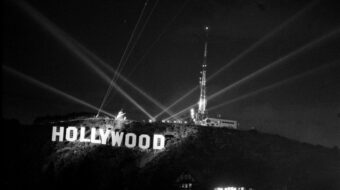
Paul Robeson’s legacy in the 21st century
OAKLAND — Fifty years ago, when legendary civil rights and peace leader, athlete, and artist Paul Robeson was being hounded by McCarthy-era witch-hunting committees, deprived of his livelihood and his right to travel, few would have guessed that soon after the turn of the century, Robeson’s fame would be carried throughout the nation by a beautiful 37-cent postage stamp bearing his portrait and calling him “an incomparable artist and singer, human rights advocate, scholar and athlete, defender of Black freedom.”
Of the many tributes paid to Robeson during and after his 1998 centennial year, the stamp, Number 27 in the Black Heritage series — issued in 2004 in a run of 130 million — has had by far the broadest impact. And while the groundswell of centennial-inspired activity has subsided, the publications, recordings, videos and films prepared for the celebration live on to inspire future generations with the achievements of a man whose uncompromising stance for peace, civil liberties, social and economic justice and socialism helped prepare the great peace and civil rights upsurges of the second half of the century.
The leader other leaders studied
“When young people and adults study the rich and difficult history of the movement for civil rights and justice in this country,” said Mark Rogovin, a leader in the campaign to win the stamp and in organizing Chicago’s centennial observances, “I think it is important that they study Dr. King, Malcolm X, and other leaders — and then that they look to see who these leaders studied — a great man like Paul Robeson.” He added that the campaign itself was an educational experience. Children who signed petitions while visiting Chicago’s DuSable Museum of African American History grew up to see the stamp years later, “and some of them will have the interest to pick up a book on Robeson, or see what they can find on the Internet.”
The Citizens’ Stamp Advisory Committee (CSAC) said it received some 90,000 petition signatures, but Rogovin said his committee estimated the number as closer to a quarter-million. During more than five years of a drive whose initiators included folk music great Pete Seeger, Dr. Margaret Burroughs of the DuSable Museum and Veterans for Peace activist Leroy Wolins, hundreds of individuals and organizations circulated petitions. Then-Congressman Ronald Dellums and other members of Congress signed letters to the CSAC, as did members of California’s Legislature.
Bay Area committee continues its work
Of the many committees formed around the 100th anniversary, only the Bay Area Paul Robeson Centennial Committee (BAPRCC) is still active today. It has loaned many items to the African American Museum and Library at Oakland’s new Robeson exhibit, which opens April 8. The committee’s vision for the future includes developing a Paul Robeson curriculum for the public schools.
It’s important for youngsters, particularly those of African American descent, to know about Robeson as a scholar as well as an athlete, said BAPRCC chairperson Grover Dye. “A lot of kids, particularly of African descent, view athletics as a road to success, and some feel that if you do that, it’s enough,” Dye said. “Here is a really tall tree who is both an All American and a Phi Beta Kappa — an African American male they can identify with who is also a scholar.”
Dye stressed the 21st-century relevance of the great artist’s outspokenness for civil rights and liberties, calling Robeson “a man who believed in the First Amendment, going all out against infringement on people’s rights to speak their minds.” What Robeson did in the 1950s “is just so fitting with some of the things going on now with the government and the Patriot Act,” he added.
Formed in 1997, the BAPRCC organized over 20 centennial events in the region, including concerts, workshops, exhibits, film showings, radio programs, theatrical performances and talks on Robeson’s legacy. The committee also began what has become a remarkable collection of memorabilia, featuring sound and video recordings, photos, art works, posters, buttons, and printed programs and souvenir booklets from his appearances and from tributes to him. Among the highlights: a 1928 theater program for “Show Boat” at London’s Theatre Royal, a 1934 British “Radio Celebrities” card — No. 23 in a set of 50 cards — and 1949 original newspaper clippings about the Peekskill, N.Y., concert where Robeson was attacked by racist mobs and defended by organized groups of workers. The committee has received materials from many countries as well as from around the United States.
Many ways to learn about Robeson
“Robeson’s life was so multifaceted that there is no one best way to introduce his work to new audiences,” said BAPRCC’s director of research and archives, Bonnie Weiss. “That’s what makes it easier — he can fit in with the sports program, the drama department, the music department — any school situation.”
For an African American in the U.S. in the first half of the 20th century to achieve distinction in one of the fields in which Robeson excelled took great courage and effort, Weiss said. “But that he achieved all these things as a Black man, and that he would never back down no matter how much he was attacked for his stands for peace and justice, civil liberties, workers’ and civil rights — that’s what makes him such a great role model.”
Besides a rich display of memorabilia, the new exhibit at the African American Museum and Library of Oakland features audiovisual materials representing the various phases of Robeson’s life, Rick Moss, the museum director, said. “Each section has between seven and nine minutes of video with Robeson actually talking about the issues for that section, and people can look at his life and each period to get the full measure of the man.”
Moss said museum staff are especially looking forward to introducing young people to Robeson for the first time, and hope the exhibit will also help teachers address the complex issues their students face in the larger society today.
Robeson’s political legacy
Calling Robeson “a great fighter for equality and world peace, a genius who gave his heart and soul to the people,” Jarvis Tyner, executive vice chair of the Communist Party USA, said he “embraced all the advanced ideas of the CPUSA, the need for a socialist transformation of society, for unity of Black, Brown, and white. If you look at his writings and you know the party’s history and policies,” Tyner added, “he was an important figure, helping to give leadership in the party’s formulation of its policies.”
If Paul Robeson could stand up in the McCarthy period, and face all the anti-Soviet, anticommunist and racist propaganda of that time, Tyner said, “we can do no less than to stand up today in the fight to end the war in Iraq and to win the domestic war against poverty, racism, inequality and for democratic rights.”
Robeson’s legacy also resonates deeply in the labor movement. Citing Robeson’s words: “To be free — to walk the good American earth as equal citizens, to live without fear, to enjoy the fruits of our toil, to give our children every opportunity in life — that dream which we have held so long in our hearts is today the destiny that we hold in our hands,” Erica Smiley, media coordinator for Jobs with Justice, observed that people in the U.S. and around the globe still struggle to realize that dream. Robeson expressed the “guiding principles for which we have fought and continue to fight,” she said.
Finally, over a century after his birth, Paul Robeson is entering the digital age. The New York City-based Paul Robeson Foundation has announced a “30-year mission” to build the Paul Robeson Legacy Virtual Archive. Reporting that it has already scanned over 10,000 photos, letters, diaries, writings, and confidential government files, the foundation plans to do an additional 100,000 scans, as well as digitizing some 800 hours of documentary and feature films, recordings and live performances.
The sum total of these efforts — and those to come in future years — is to make available a political and artistic legacy that speaks directly to all the people’s struggles of the present day.
— Marilyn Bechtel
Paul Robeson’s life in brief
Paul Robeson, famous athlete, scholar, singer, actor, and civil rights advocate, rose to fame at a time when segregation was legal in the U.S., and Black people were being lynched by racist mobs.
Robeson was born April 9, 1898. His father, a runaway slave, graduated from Lincoln University, and his mother came from an abolitionist Quaker family.
Robeson attended Rutgers University on a four-year academic scholarship. He won 15 varsity letters and was twice named to the All-American football team. He became Phi Beta Kappa in his junior year and graduated as valedictorian.
At Columbia Law School, Robeson met and married Eslanda Cardoza Goode, who would become the first Black woman to head a pathology laboratory. He took a job in a law firm but left when a white secretary refused to take dictation from him. He then shifted to an acting and singing career.
Among Robeson’s many dramatic credits were the title roles in Eugene O’Neill’s “Emperor Jones” and Shakespeare’s “Othello,” and Joe in Kern and Hammerstein’s “Showboat.” He made 11 films.
Paul Robeson used his deep bass-baritone voice to promote Negro spirituals, to interpret the cultures of other countries through song, and to support the labor and social movements of his time. He sang for peace and justice around the world in 25 languages.
During the 1940s Robeson continued to perform and speak out against racism and for labor and peace. He protested growing Cold War hostilities and worked tirelessly for U.S.-USSR friendship. In 1946 he headed the American Crusade against Lynching. In the late 1940s, when dissent was scarcely tolerated in the U.S., he openly questioned why African Americans would want to take up arms against anyone in the name of those who have oppressed them.
Because Robeson was outspoken, he was targeted by the McCarthy era witch-hunting House Un-American Activities Committee. Robeson refused to yield to the committee, which he considered to oppose freedom of expression of those working for international friendship and peace. Sixty of his concerts were cancelled, and in 1949 two interracial outdoor concerts in Peekskill, N.Y., were attacked by racist mobs. “I’m going to sing wherever the people want me to sing,” Robeson responded, “and I won’t be frightened by crosses burning in Peekskill or anywhere else.”
In 1950 the government revoked Robeson’s passport, leading to an eight-year battle to win it back and to travel again. Beginning in 1952, the Mine, Mill, and Smelter Workers Union sponsored four annual Robeson concerts at Peace Arch Park on the U.S.-Canadian border, with as many as 40,000 in attendance.
In ill health, Robeson retired from public life in 1963. He died Jan. 23, 1976, at age 77.
(Adapted from Paul Robeson’s Living Legacy, by Barbara Armentrout and Sterling Stuckey, 1999.)











